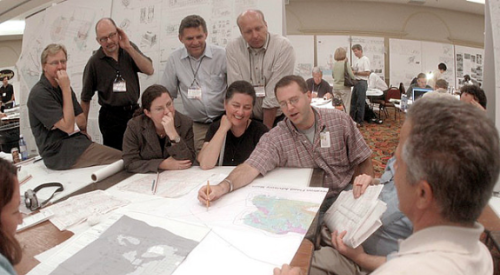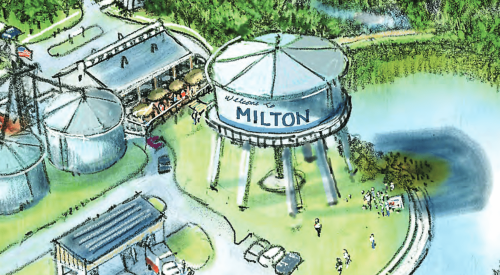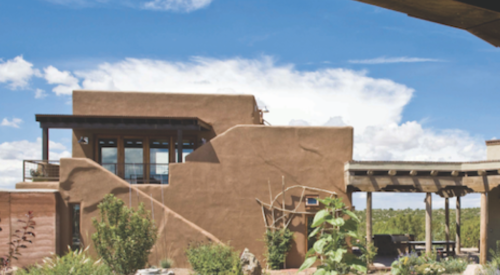|
Heather McCune's Editorial Archives
|
Building with trees doesn’t mean stick-frame construction - at least not in this instance. Rather, Building with Trees is a national awards program that recognizes conservation-minded builders and developers who actively work to save and protect a site’s existing trees during construction.
The residential category winners of this program, sponsored by the National Arbor Day Foundation and the National Association of Home Builders, are conservation-minded, but each is a business owner as well. For them, saving trees doesn’t only make ecological sense; it makes economic sense as well. Developments with open green space and lots with mature trees usually sell first and for the highest premium.
Award winners in the residential development category (26 to 100 lots) are Eagles Landing, a project of C.P. Morgan Communities, Carmel, Ind.; and Oak Alley, a Larkin Development Corp. project in Bossier City, La. In the residential/pair housing category the award winner is Jackson Park, a Savannah Land Co. project in Savannah, Ga. A closer look at each of the winners reveals a few similarities:
"The existing landscape determined the layout of our park," said Gerry Cowart, architect of the winning Jackson Park project. "The primary trees helped us place our buildings around them. They shaped the concept of how we would use the land."
Eagles Landing
This community is comprised of 91 lots on 39 acres in Indianapolis. Careful planning and design preserved 11 of 21 acres of existing woods. Hammerhead cul-de-sacs were used to minimize the impact of existing trees. Rear yards allowed for retention of tree preservation corridors and enhanced the appearance and value of the homes.
Three natural wetland areas were created to aesthetically and ecologically enhance the area. A substantial area of the site was left open for recreation. A perimeter road was incorpo-rated into the design of Eagles Landing and was built in unforested areas on the fringe to allow preservation of additional trees.
Home builders and buyers at Eagles Landing were required to sign a document agreeing to comply with the provisions in the developer’s tree preservation plan. Failure to do so resulted in work stoppage and/or fines. Builders were required to submit individual building plans for the site that showed how they would minimize impact on existing trees.
Oak Alley
This development is located on 75 acres of land that was originally a cotton plantation in Bossier City, La. On the property are several 250-year-old oak trees. It is also believed that the first pecan trees in the state were grated from trees on the Oak Alley property. Each one of these trees -- and all the others as well -- were numbered and mapped by Larkin Development Corp. at the outset. Trees not requiring removal were fenced off during construction.
Utility companies were required to bore around trees to install the underground systems and whenever any boring was done a member of the tree protection team had to be on hand to supervise, making sure no root systems were injured.
The meandering streets and sidewalks for Phase One’s 73 homes were planned around the trees, and all home sites are located within cul-de-sacs that intersect a tree-lined boulevard. In addition to the preservation of old growth trees, 186 14-year-old live oak trees, salvaged from a project in Arkansas, were transplanted along the boulevard.
Jackson Park
The goal of the Savannah Land Company in the development of this project was to create a park similar in feel and in use to the historic squares in the original city plan that was created by General James Ogelthorpe. Also important was preserving as much of the natural vegetation as possible on the heavily wooded, five-acre tract of land.
After the review of several development scenarios, it was decided to create a large park in the center of the development, surrounded by eleven townhouse buildings, each containing two units. This design allowed for the retention of groupings of trees, as well as the formation of a homeowner’s association to maintain the park.
Trees were left in very close proximity to the buildings and footprints of buildings were moved in order to preserve important trees. Under the guidance of tree expert Danny Nelson, significant tree protection measures were taken during the site development phase, including the use of smaller earth-moving equipment and street widths narrower than standard.
Jackson Park has been cited by the City of Savannah for its uniqueness in helping to pre-serve the urban forest in Savannah, and for setting an example for other developments.
Read All About It
To learn more about the Building with Trees recognition program contact the National Arbor Day Foundation in Nebraska City, Neb., at 888-448-7337.
Heather McCune is the Editor-in-Chief for Professional Builder and Luxury Home Builder. Please email her with any comments or questions regarding her column.












